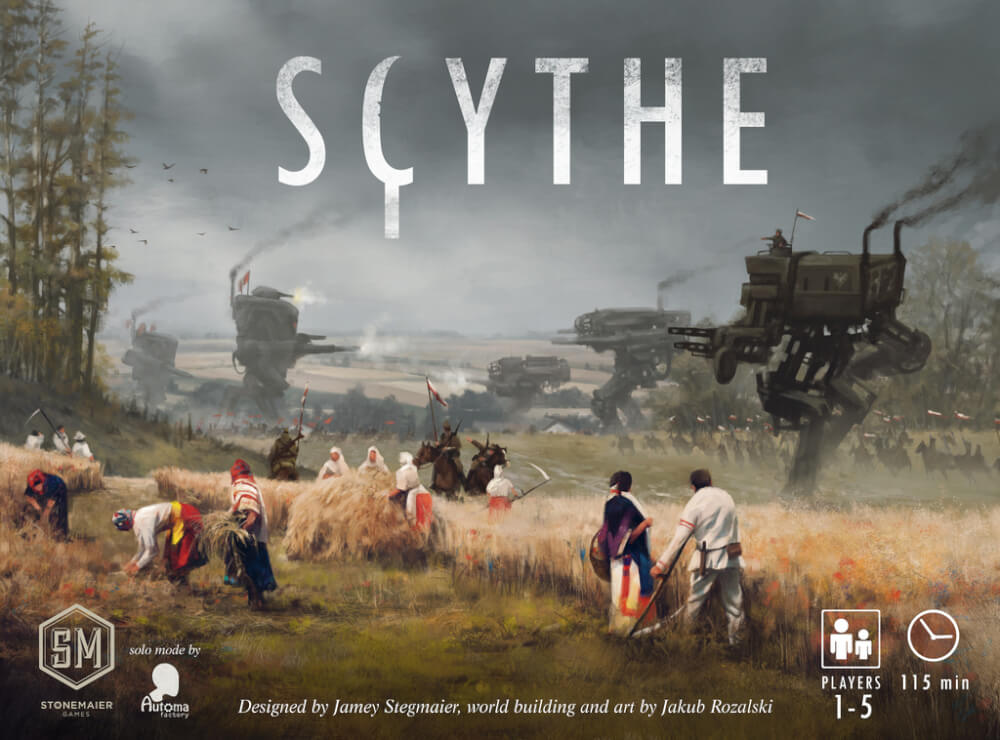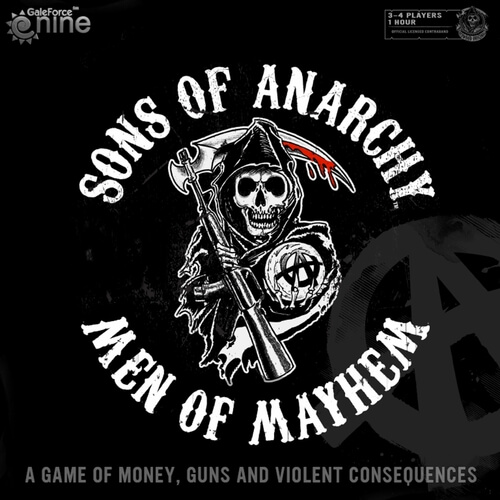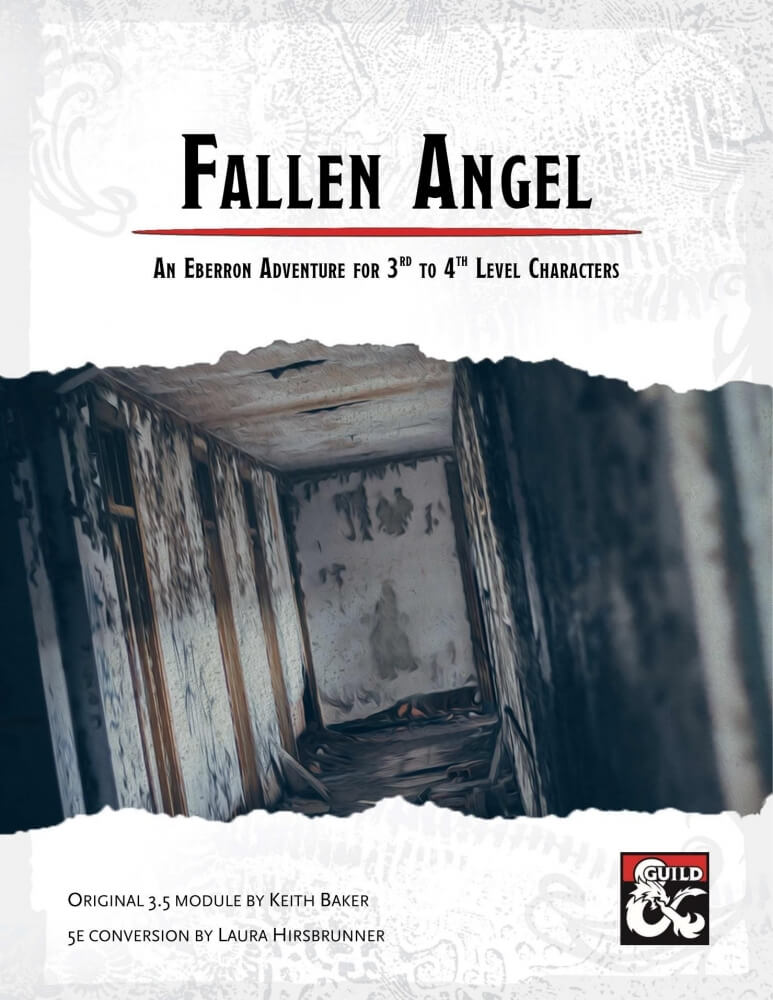
Scythe
In Scythe, 1920s Europe boasts a post-war landscape full of opportunities and tensions. With the city-state known as "The Factory" abandoned after supplying armaments for the Great War, five rival factions vie for control of this valuable territory. Each player takes on the role of a Hero who aims to expand their empire, increase their faction's wealth and gain leadership in the region. During the game, participants venture into unexplored lands, recruit new soldiers and manage essential resources. The construction of strategic structures and the movement of Mechas - imposing war machines - are key to ensuring dominance on the board. The dynamics of Scythe are marked by a cold war, in which direct confrontation is a cautious choice, and control of territory is vital for the production of resources and the fulfillment of personal objectives that are drawn at the start of the game. Players accumulate stars by achieving different types of triumph, and the match ends when one of them places their 6th star on the Triumph Register. The winner will be the one who, in the end, proves to be the most cunning, earning points according to their faction's popularity, possession of resources and control of territories. Scythe is therefore an experience rich in strategy, negotiation and careful planning, where peace is as valuable as war.Artists: Jakub Rozalski;
Designers: Jamey Stegmaier; Morten Monrad Pedersen
Date: 2016
Note: 8.7
Mechanics: Trees / Technology Trails, End of game bonus, Contracts, Narrative Choice, Hexagonal grid, Players with Different Skills, Movement in Grids, Movement Points, Victory Points as a Resource, Variable preparation, King of the Hill, Conflict Resolution by Letters, Solo, Take that
Topics: Economy / Production, Science Fiction, Fighting / Martial Arts
Table of Contents
- How to Play
- Tips for playing
- Game mechanics
- Game components
- Additional Information
OBJECTIVE OF THE GAME
Tips for playing
Here are some tips for doing better in the game Scythe:
- Prioritize the expansion of your territory at the start of the game to guarantee access to crucial resources.
- Build mechs quickly to increase the mobility of your units and improve their combat and defense skills.
- Manage your achievement stars well; completing specific objectives can be more effective than focusing only on battles.
- Use your faction skills strategically, each faction has unique advantages that can be decisive.
- Negotiate resources and strategies carefully, as alliances and exchanges can have a profound impact on the dynamics of the game.
- Pay attention to your opponents' combat board and avoid making unplanned attacks.
- Consider timing special actions at key points in the game, especially at times when you can surprise your opponents.
- Improve your economic infrastructure, such as buildings and upgrades that increase resource production.
- Observe the movements of other factions to anticipate their strategies and prepare appropriate responses.
- Focus on versatility, adapting your tactics based on developments on the battlefield and the advance of your opponents.
Video about the game
GAME mechanics
- **Players with Different Skills: Each player represents a unique faction with special skills. These abilities alter the strategy and approach of the game, providing diversity of gameplay and promoting different styles of leadership and conquest.
- **Grid Movement The map is segmented into a hexagonal grid, allowing for the strategic movement of units. Movement choices are crucial to controlling territories and resources, directly influencing expansion and combat tactics.
- **Conflict Resolution by Cards**: When combat occurs, players use secret combat cards in conjunction with their power points. This system adds an element of bluffing and strategy, where anticipating the opponent's actions can determine the outcome.
- **End-of-game bonuses: At the end of the game, players receive bonuses based on various achievements, such as popularity and control of territories. These bonuses can drastically influence the final score, encouraging different tactics during the match.
- **Contracts: Secret objective cards are distributed, encouraging the fulfillment of specific tasks. Completing these contracts awards additional victory points, guiding players' strategic decisions.
- **Hexagonal Grid**: Fundamental to the structure of the game, the hexagonal grid allows for strategic variations in movement and control of territory, directly impacting interactions and combat between factions.
- **King of the Hill: Factions must control strategic areas in order to accumulate a competitive advantage. This mainly includes control of key scoring locations, which measure territorial influence on the board.
- **Movement Points: Each unit moved consumes movement points based on its abilities and restrictions. Efficient management of these points is essential to optimize territory control and combat efficiency.
- **Narrative Choice**: Events found on the board offer narrative decisions that can alter the course of the game. These choices affect both the story and the resources available to the players.
- **Take that: Interactions between players include direct conflict mechanics, where a player's actions can negatively impact their opponents' resources, units and territory.
- **Technology Trees / Trails**: Development and improvement of factions are represented by progress trails that strengthen their skills and units. Prioritizing certain advances can define tactical effectiveness in later stages of the game.
- **Solo: Scythe offers a solid experience in solo mode, allowing individual players to face an automation system with its own rules, challenging their strategic skills without the need for other players.
- **Variable Preparation**: Each game starts differently with the distribution of resources and skills, guaranteeing a unique experience in each match and encouraging constant adaptation of strategies.
- **Victory Points as a Resource**: Victory points not only determine the winner, but also serve as a strategic resource during the game. They can be 'spent' or exchanged in certain situations, adding an extra layer of strategy to long-term decisions.
Game components
See all the items in the game below Scythe:
- 1 Instruction manual
- 1 Quick reference sheet
- 40 combat cards
- 23 Mission letters
- 30 Unexpected event cards
- 12 Innovation charters
- 5 Crossing charts
- 5 Faction reference cards
- 5 Stock panels
- 5 Faction boards
- 1 Central tray
- 80 Moedas (25x1, 15x3, 15x5, 15x10, 10x20)
- 12 Resource multiplier sheets
- 12 Event sheets
- 6 Building bonus cards
- 2 Power disks
- 80 Resource markers (20 grain, 20 metal, 20 wood and 20 oil)
- 5 Action markers (1 per faction)
- 5 Popularity markers (1 per faction)
- 5 Power markers (1 per faction)
- 30 Achievement markers (6 per faction)
- 20 Building markers (4 per faction)
- 20 recruitment markers (4 per faction)
- 20 mecha miniatures (4 per faction)
- 5 Hero miniatures (1 per faction)
- 40 "Meeples" of workers (8 per faction)
- 30 technology cubes (6 per faction)
Additional Information
- Ludopedia link: https://ludopedia.com.br/jogo/scythe
- Link Tabletopia: https://tabletopia.com/games/scythe
- Amazon Brazil link: Comprar Scythe
- Amazon USA link: Comprar Scythe


